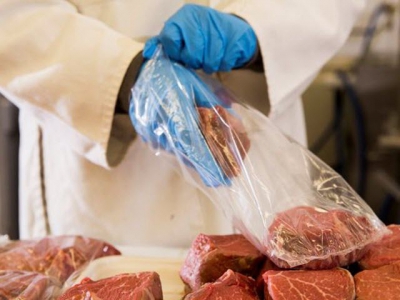New technique aims to improve aging of beef

Texas Tech researchers are evaluating the use of new mass spectrometry technology to determine tenderness, flavor and juiciness of beef in real time.
Determining the proper aging time for meat has been tricky. Researchers at Texas Tech are hoping to increase that accuracy in real time.
Beef producers strive to give consumers tender, tasty and juicy cuts of meat, and one of the most time-honored and effective ways of doing so is aging beef to bring out as much flavor and tenderness as possible, according to an announcement from Texas Tech University.
However, aging the beef can be tricky, and research has shown that over-aging beef can bring about compositional changes that affects beef flavor, and not in a good way, Texas Tech said.
Recently, a new technology has been developed that can help avoid over-aging. Rapid Evaporative Ionization Mass Spectrometry (REIMS) utilizes metabolomics — the large-scale study of small molecules called metabolites within cells, biofluids, tissues or organisms — to identify compositional differences in beef. The goal is to predict beef sensory performance to determine the exact peak of beef aging.
Because it is a novel technology, its effectiveness hasn't been definitively determined, the university said. A group of researchers in the Texas Tech College of Agricultural Sciences & Natural Resources, in collaboration with researchers at Colorado State University and the U.S. Department of Agriculture-Agricultural Research Service, is taking on that task.
Backed by a $294,000 grant from the USDA National Institute of Food and Agriculture (NIFA), Dale Woerner, an associate professor and the Cargill Endowed Professor in Meat Science in the department of Animal & Food Sciences (AFS), is leading this research project.
Their goal is to develop REIMS as a real-time method for classifying the quality of beef products by evaluating REIMS' ability to predict beef sensory and tenderness, identify changes in beef flavor and tenderness as it ages and characterize the effect of extended aging on palatability.
"We are very excited to collaborate on this effort aimed at discovering the potential of a very unique technology to differentiate the quality of beef products," Woerner said. "This technology, among others, is the future of differentiating quality and safety attributes of agricultural products intended for food."
Collaborating with Woerner on the project are assistant professor Jerrad Legako, Mark Miller, a professor and San Antonio Livestock Show & Rodeo chair in meat science, and professor Chance Brooks, all part of AFS and the International Center for Food Industry Excellence at Texas Tech. The study also is supported by the National Cattlemen's Beef Assn.
REIMS using time-of-flight mass spectrometry to provide in-situ, molecularly resolved information in real time by ionizing biological samples without having to prepare the sample for examination. Utilizing both domestic and exported beef samples with a wide variety of aging days, researchers will use REIMS to repeatedly measure beef flavor, tenderness and juiciness.
They then will develop prediction models, including multiple machine-learning processes, in an attempt to understand the ability of REIMS to measure and predict these changes depending on the time the beef has aged. If successful, this would allow these characteristics to be predicted in real time and produce optimum cuts of meat in regards to tenderness, flavor and juiciness.
Source: Texas Tech University, which is solely responsible for the information provided and is wholly owned by the source. Informa Business Media and all its subsidiaries are not responsible for any of the content contained in this information asset.
Related news
 Leading Egyptian dairy farm championing feed self-sufficiency
Leading Egyptian dairy farm championing feed self-sufficiency Autonomy in feed production for Egypt’s largest dairy business, Dina Farms, is one of the reported ambitions of its owner
 Facility to use manure, food waste as renewable energy
Facility to use manure, food waste as renewable energy Middlebury College in Vermont to be primary buyer of renewable natural gas produced at local dairy farm.
 Methane busting strategies: NZ farmers to pay for their emissions?
Methane busting strategies: NZ farmers to pay for their emissions? New Zealand's interim Climate Change Committee has released advice to the government there on how to reduce agriculture's methane and nitrous oxide emissions